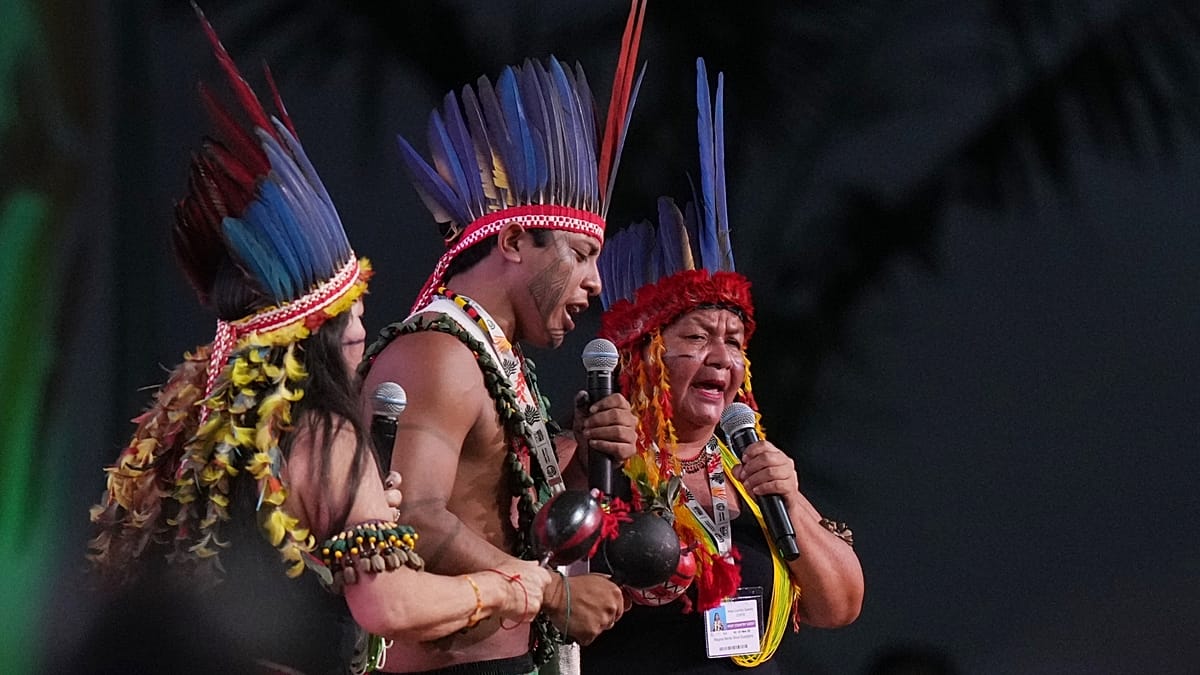This year, traditional Indigenous attire will stand proudly among suits and ties at COP30. The UN climate conference opened on Monday in Brazil’s Amazon city of Belém, where Indigenous peoples are expected to play an unprecedented role.
Scientists consider Indigenous communities — and the demarcation of their territories —as vital to protecting the environment and combating global warming.
Hosting this year’s conference in the Amazon, a first for COP, offers a unique opportunity to highlight this role.
The Brazilian government has prepared a series of initiatives to amplify local voices at COP30, including the participation of a record-breaking 3,000 Indigenous peoples.
Around 1,000 will be directly involved in official negotiations, which take place between delegations in the so-called Blue Zone. The remaining 2,000 will attend the Green Zone, a space for civil society organisations, youth groups, activists, and the public.
In an exclusive interview with Euronews, the Minister of Indigenous Peoples of Brazil, Sônia Guajajara, advocated for the inclusion of Indigenous communities in decision-making processes and international forums.
“We are dealing with solutions to mitigate the climate crisis and Indigenous territories and peoples are proven to be the ones that preserve the most biodiversity and forests,” Guajajara said.
“They make a very significant contribution to balancing the climate through their own way of life. So there’s no way to think of solutions without considering those who are protecting (the environment) and who are already being directly impacted by the climate crisis.”
Tropical Forest Forever Facility
Brazil’s main proposal for COP30 is the creation of the Tropical Forest Forever Facility (TFFF), a fund that aims to protect standing tropical forests, with 20% of its resources reserved for Indigenous peoples.
The project envisages a total contribution of $125 billion (€108bn), with $100 billion (€86.5bn) coming from private investors and the remainder from government and philanthropic sources. So far, the largest contribution has come from Norway, which has pledged $3 billion (€2.6bn).
The ‘Peoples’ Circle Pavilion’ is a fundamental element of COP’s Green Zone. It is a space launched by the International Indigenous Commission, under the leadership of Guajajara, and the International Commission for Traditional Communities, Afro-descendants and Family Farming, coordinated by the Brazilian Minister for Racial Equality, Anielle Franco.
The pavilion provides a platform for Indigenous peoples and other key communities in environmental protection to share their experience in the fight against the climate crisis.
Accommodation for the thousands of Indigenous participants was also designed to encourage dialogue and interaction, with centralised accommodation in the COP Village.
The National Foundation for Indigenous Peoples (FUNAI), the Brazilian agency that operates under Guajajara’s portfolio, has launched the Biodiversity Space.
Indigenous producers can showcase and sell their products there. Meanwhile, FUNAI has organised the Echoes of the Earth Film Festival, held at Belém’s Museum of Image and Sound, featuring more than 30 screenings centred around Indigenous communities.
“The main challenge for countries and global leaders is to understand the centrality of Indigenous participation in decision-making,” Guajajara told Euronews.
“[At this COP], we are working on organising and encouraging Indigenous people to make a direct impact both at the negotiating table and across parallel agendas, so that we can have a greater awareness, understanding and dialogue surrounding the contribution of Indigenous communities, which is still not fully recognised by legal structures of global conferences.”
Ahead of the conference, Brazil promoted the ‘Kuntari Katu’ — which means “the one who speaks (for the people and on behalf of the people)” in the Nhengatú language — a training programme that prepares Indigenous diplomats for climate negotiations.
The programme offered language courses, of a series of events that informed Indigenous communities about the structure and working of the climate conference.
The executive director of the Amazon Environmental Research Institute (IPAM), André Guimarães, highlighted the importance of Indigenous representation in the Green Zone for influencing official negotiations.
“During the days of the conference, the negotiators end up being influenced by what they see outside the rooms: the demonstrations, the demands of the Indigenous communities, the actions of young people and organised civil society,” Guimarães said.
“This presence is essential because these groups are fundamental in preserving the climate and natural resources and, at the same time, are the most vulnerable to climate change, since they depend directly on nature — rivers, fishing, rain cycles — to maintain their cultures and quality of life,” he added.
“That’s why our presence in Belém is both symbolic and practical: it shows the world that Brazil is a democratic, open country that respects differences. And that the voice of these communities needs to reach the decision-making processes.”
Data proves importance of Indigenous territories
In Brazil, Indigenous lands cover approximately 105 million hectares — 13.8% of the national territory — contributing directly to environmental preservation. In 2024, these regions accounted for just 1.3% of all deforestation in the country.
Experts attribute this protection to the sustainable relationship Indigenous peoples maintain with the environment, which acts as a safety net for ecosystems.
Since 2023, when President Lula da Silva started his current term in office, the federal government has recognised 16 new Indigenous territories.
The creation of the Ministry of Indigenous Peoples, one of Lula’s campaign promises, marked an institutional milestone, with Guajajara appointed to lead the ministry. She is widely recognised for her leadership and activism in defending Indigenous rights.

